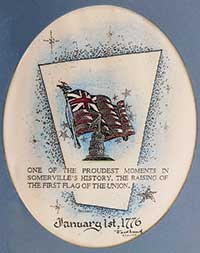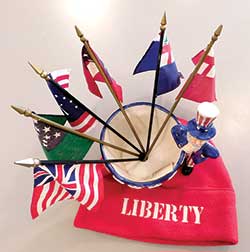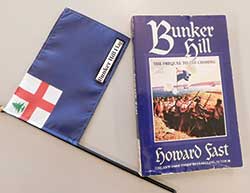
Eagle Feathers #181 –A Banner Weekend
By Bob (Monty) Doherty
Somerville is the first location in America to celebrate its flag before the constellation of stars on it began to grow. After the Battle of Bunker Hill, Colonial troops withdrew to fortify Prospect Hill. It was there, during the next year, that America’ s union began to form. Prospect Hill became known as General Washington’s Citadel, his command post during the siege of Boston.

The first banner to fly over the fort was General Putnam’s flag. It honored Connecticut on one side with its armorial shield and Massachusetts on the other side with its “An Appeal to Heaven” motto. Most of the next year would observe many signal flags and regimental flags from as far away as Virginia.

This past weekend it was quiet in Somerville even though it celebrated three holidays.
- It began on Friday, June 14, with Flag Day, a day set aside to honor our American flag. The Continental Army was established on this date in 1775, and General Washington took command on the 15th. The suggestion to salute Flag Day was noted as early as 1861 during the Civil War. The holiday was proclaimed by President Woodrow Wilson in 1916 and was recognized by Congress in 1949.

- Sunday, June 16 was Father’s Day. It honors all fathers past and present including George Washington, the first commander of our army and “the father of our country.”

- Monday, June 17 celebrated the Battle of Bunker Hill and the flag the Patriots fought under. The night before the battle 244 years ago, the Americans had stealthily marched through Somerville into Charlestown. After battling the next day and until their gunpowder was exhausted, they withdrew to Prospect Hill under the Pine Tree Flag to begin the siege of Boston.

General Washington was present six months later on January 1, 1776, at Somerville’s Prospect Hill, commanding the first American-flag raising. This flag, the Grand Union Flag, was made up of the British ensign in its contour and thirteen stripes of red and white to represent the American colonies. This was our American flag at the beginning of the Revolution.

The British flag, or the Union Jack, represented the unification of England and Scotland. It consisted of England’s red cross of Saint George, the dragon killer, and Scotland’s blue diagonal cross of Saint Andrew, the martyred brother of Saint Peter. Today’s United Kingdom banner includes a third cross honoring Ireland’s Saint Patrick.

After two years into the revolution, the British Union Jack, as it was called, was dropped from our flag and replaced with stars, thirteen radiant ones representing the thirteen colonies. Today, she bespangles with fifty stars representing our fifty states … the greatest banner of all!















Reader Comments